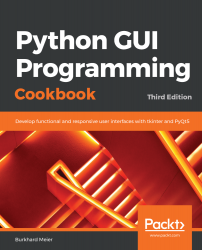Python comes built in with OOP capabilities, but at the same time, we can write scripts that do not need to use OOP. For some tasks, OOP does not make sense.
This recipe will show us when not to use OOP.


 Free Chapter
Free Chapter












Python comes built in with OOP capabilities, but at the same time, we can write scripts that do not need to use OOP. For some tasks, OOP does not make sense.
This recipe will show us when not to use OOP.
In this recipe, we will create a Python GUI similar to the previous recipes. We will compare the OOP code to the non-OOP alternative way of programming the GUI. The resultant output will be the same but the code of the two versions is slightly different.
Let's see how to perform this recipe: